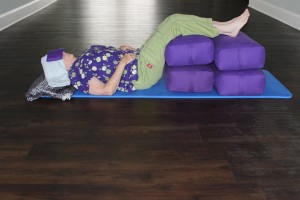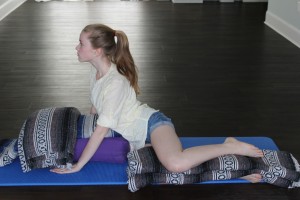Restorative Yoga Practice – Poses for Anxiety
The following poses are intended to help you relieve some of your stress.
Supported Balasana (Child’s Pose)
Setup:
- Place your knees hip width distance apart on the floor.
- Rest your bottom on your heels. If you feel discomfort in this position, place a rolled blanket underneath your ankle joints to prevent strain on the ankles. A folded blanket can be placed between your hamstrings and calves to prevent knee and/or hip strain.
- Place one bolster vertically in front of you.
- Cross a second bolster over the first bolster.
- Lay your torso over the second bolster. In this position, your torso should be fully supported. Your spine should have a gentle upward slope. Your torso should not be angled towards the floor. Your arms can gently hug the second bolster or you can use additional bolsters/blankets to prop your arms.
- Turn your head to either side.
Key Propping Areas:
- Ankles: a rolled blanket can be placed underneath your ankle joints to prevent strain on the ankles
- Knees/Hips: a folded blanket can be placed between your hamstrings and calves to prevent knee and/or hip strain
- Torso: additional folded blankets can be placed on top of the second bolster to elevate your torso
- Head: additional folded blankets can be placed on top of the second bolster to elevate your head
Benefits of Child’s Pose:
- Nervous system body: quiets the brain
- Emotional body: enhances calmness, creates a sense of safety and security
- Physical body: reduces tension in posterior muscles of the back, head, and neck; stretches the lower back, opens hip flexors, stretches feet
Contraindications:
- You are more than 12 weeks pregnant
- You have a severe back injury
- You have severe arthritis in the hip joints
Supported Reclining Twist
Setup:
- Sit down on the floor and extend your legs toward the front wall.
- Fold your legs, placing your left leg on top of your right leg. Place a folded blanket or bolster between your knees in order to avoid compression of your hips.
- Place a bolster on the floor so that it vertically intersects your right hip.
- While your torso is still upright, twist your lower left waist to the right.
- Descend straight down over the bolster.
- Turn your head to the left and rest it so that the right side of your head is touching the bolster.
Key Propping Areas:
- Hips: place a blanket (or a few blankets) between your thighs if you feel strain in your hips
- Torso: place folded blankets vertically on top of the bolster to support your torso
- Arms: use folded blankets or blocks to support your arms
- Neck/Head: lie folded blankets horizontally across the bolster to support your neck/head
Benefits of Supported Reclining Twist:
- Nervous system body: quiets the brain
- Emotional body: quiets distress and anxiety
- Physical body: reduces tension in posterior muscles of back, lateral, and neck muscles
Contraindications:
- Proceed carefully if you have severe back problems
- Can be difficult if you have sacroiliac joint issues
Gentle Inversion
 Legs Extended Over Two Bolsters
Legs Extended Over Two Bolsters
Setup:
- Fold a blanket. Lie down on this blanket so that the ridge of the blanket lies along the bottom tips of your shoulders.
- Legs can either be extended over two bolsters or bent with bolsters weighting the legs.
- Use a folded blanket to support your neck/head.
Key Propping Areas:
- Lower back: if you feel lower back strain, rest with your knees bent, place your feet hip-width distance apart, place the soles of our feet on the mat, then rest knees together
- Shoulders: if your shoulders are extremely tight, blankets can be used to provide additional neck support
- Neck/Head: a folded blanket can be used to support your neck/head
Benefits:
- Nervous system body: quieting and balancing
- Emotional body: uplifting and balancing
- Physical body: lowers tension in anterior body; lowers blood pressure and drains lymph; can reduce tension headaches
Contraindications:
- You have a detached retina or eye pressure issues
- You have spondylolisthesis or sphondylolysis
Supported Side-Lying Pose
 Vertically Extended Arm
Vertically Extended Arm
Setup:
- Lie on your right side, placing a bolster against your back.
- Bend you legs. Place a blanket between your thighs to avoid compression of your hips.
- Extend your bottom arm. Place a blanket under this arm.
- Place another blanket under your head for neck/head support.
- Rest a bolster so that the short end of the bolster is touching your belly. Make sure this bolster is parallel to your bottom arm. Extend your top arm over over this bolster.
- Align your head with your shoulders and body.
Key Propping Areas:
- Top leg: place blankets between your top and bottom legs to support your hips
- Bottom arm: use a folded hand towel to support the wrist on your bottom arm, if necessary
- Top arm: use a bolster and blanket to support your top arm
- Neck/Head: use a folded blanket to support your neck/head
Benefits of Supported Side-Lying Pose:
- Nervous system body: calming to brain and nervous system
- Emotional body: comforting
- Physical body: good for lower back pain; stretches side muscles
Contraindications:
- If you are more than 12 weeks pregnant, do not practice this pose on your right side (you can practice this pose on your left side)
- Discontinue this pose is back pain is present
Viparita Karani (Legs-Up-the-Wall Pose)
Setup:
- Align the short end of mat against the wall.
- Place a folded blanket against the wall.
- Lie down on your back and elevate your legs up the wall, ensuring the folded blanket is underneath your pelvis.
- Support your neck/head with a blanket.
- Your hands can be place on top of your belly or extended towards the wall.
Key Propping Areas:
- Pelvis: place a folded blanket under your pelvis, if necessary
- Neck/Head: use a folded blanket to support your neck/head
**Modified Viparita Karani – practice the modified version of viparita karani if you have lower back pain or your hamstrings are tight

Setup:
- Lie down on your back.
- Bend your knees at a 90 degree angle and place calves on top of the bolsters.
- Support your neck/head with a blanket.
Benefits of Viparita Karani:
- Nervous system body: quieting and relaxing; extremely good for insomnia
- Emotional body: calming and energizing
- Physical body: strong lymph drainage; lowers blood pressure; good for water retention
Contraindications:
- You have a detached retina or eye pressure issues
- You are pregnant
Face-Down Savasana (Corpse Pose)
Setup:
- Lie down with a blanket under your pelvis. If you have lower back pain, increase the height of the blanket.
- You can either rest your head to either side or fold your forearms and rest your head on your forearms.
Key Propping Areas:
- Ankles: a rolled blanket can be placed underneath your ankle joints to prevent strain on the knees and hips
- Pelvis: fold a blanket length-wise and place it underneath the top of your hip bones to support your pelvis
Benefits of Face-Down Savasana:
- Nervous system body: extremely calming
- Emotional body: helps relieve anxiety
- Physical body: can relieve lower back pain by removing the anterior tilt of the spine; can alleviate tension headaches
Contraindications:
- You are pregnant













 Kate Millen is a yoga and Pilates teacher who has worked in the field of health and wellness for over 20 years. She created Giving Tree Wellness in order to provide innovative mind-body therapeutics for clients in the Middle Tennessee area.
Kate Millen is a yoga and Pilates teacher who has worked in the field of health and wellness for over 20 years. She created Giving Tree Wellness in order to provide innovative mind-body therapeutics for clients in the Middle Tennessee area.